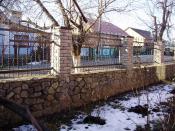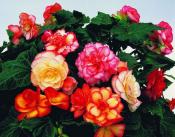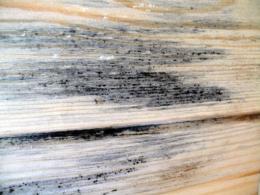Search
Login
Fungal infection of wooden structures
Wooden structures, subject to dampness, are susceptible to fungal infection. On untreated surfaces, in humid conditions, the spores of the fungus multiply until they destroy all the wood.
Content
- Mold fungus
- Wet rot
- Fungus - dry rot
- Fighting wet rot fungus
- Dry rot control
- Preventative treatment video
- Protection of door and window blocks
- Wood impregnation
- Wood preservatives video
- Security measures when working with an antiseptic
- Colored protective equipment video
- Green protective equipment
Mold fungus
Mold is a fungus whose destructive activity is manifested in the form of black spots on wood, plaster or wallpaper, sometimes it appears in the form of white fleecy formations.
If you erase the stain or clean it off, then there are no traces left at the place where the fungus grows, i.e. it is necessary to eliminate the causes of dampness, treat the infected area with a fungicide or a warm solution consisting of one part of household bleach and 16 parts of water.
Wet rot
Infection with fungus, manifested in the form of wet rot, occurs only in wet wood. The development of wet rot stops when the moisture source is removed.
When rainwater enters the connection between the brickwork and the adjacent wooden parts of the door and window frames, wet rot develops.
Peeling paint is the first sign of rot.
When removing paint, the unsightly appearance of the wood opens - it is dark brown, crumbling when dry, or porous and soft when wet.
When the fungus comes into full force, at later stages - the wood is stratified, dark brown or black strands of the fungus are clearly visible.
Conclusion: if you find wet rot - start practicing without delay.
Fungus - dry rot
The fungus infects wood at a significantly lower moisture content than wet rot, but only in dark, poorly ventilated places and if dry rot has settled in wooden structures, urgent countermeasures are needed.
This fungus can lead to serious consequences of wood damage.
Dry rot spreads very thinly with thin tubular strands or fibers, it even passes through cracks in plaster, stone, brick and concrete.
In this case, the infection develops very quickly - up to 150 mm. per month. If dry rot settles, fixing, it forms a wrinkled pancake-bearing fruit-bearing mushrooms of brown color, with smooth, white outer edges.
Rot is capable of throwing out spores, they cover the surrounding wood and brickwork with a layer of fine dust of red-rusty color, a strong smell appears, similar to mushroom.
Wood infected with dry rot becomes dark and brittle, cracks appear along and across the fibers, the result of the fungus is the breaking of the tree. At the same time, painted wood can warp and fail.
Fighting wet rot fungus
Having found wet rot, replace heavily damaged areas with new ones, and then treat it and the wood adjacent to it with three plentiful layers of a chemical agent for combating wet rot.
Do not forget to wear protective gloves, goggles and a respirator. Using a brush, carefully process all the joints and ends of the product, strengthen the areas with a special tool.
After 6 hours, after treatment with an antiseptic, treat the surface with a two-component putty for wood, then paint.
Dry rot control
If you did not find a source of dampness after examining the area of \u200b\u200binfection with dry rot, you will have to turn to specialists, they will tell you what needs to be done.
The work is usually difficult, as it requires the removal of not only damaged, but also the surrounding material.
Having eliminated the source of dampness, replacing the infected wood and removing the plaster up to one meter around the visible lesion with the fungus, it is necessary to treat all the wood, masonry and other materials with the fungicide solution at the infection site.
Additional ventilation must be provided to prevent repeated flash dry rot.
Preventative treatment
Forewarned is forearmed.
It is better to take measures to prevent fungal infection, so constantly repair and paint doors and windows, seal joints, prevent water from entering.
Eliminate all water leaks in time, provide ventilation to the ceiling and attic, and protect the wood surface with protective agents.
Protection of door and window blocks
Modern protective agents can be purchased in tablet form.
If part of the frame of the door or window blocks is in doubt, drill a checkerboard pattern from 50 mm. spacing holes and insert tablets there.
The tablets will dissolve if the wood becomes wet, so the antiseptic will penetrate to the right places. Then, fill the holes with putty and paint.
Wood impregnation
All wooden parts that will come in contact with the soil must be immersed in a protective agent for high-quality impregnation.
For example, wooden fence posts can be placed in an overnight impregnated bucket.
You can make a frame from a bar, cover it with thick polyethylene, pour a protective agent and put wooden parts into it, they must be pressed down so that they do not float. Leave to soak for 12 hours.
Wood preservatives
Modern protective equipmentmainly released on a solvent basis, after drying, they are safe for the plant.
Transparent products protect only from wet or dry rot.
There is also a universal remedy, it protects against wood borer, usually after the protective agent has dried, the wood can be coated with paint or varnish.
Security measures when working with an antiseptic
All solvent based products are flammable. When handling them, you must refrain from smoking and extinguish open fire; when working, wear protective gloves, goggles and a respirator.
When working indoors, good ventilation must be provided.
In a freshly treated room, you can go to bed only after 48 hours, so that the vapor disappears.
In case of contact with eyes and skin, rinse with water.
Colored protective equipment
There is a tool to protect the exterior of wooden parts with simultaneous staining.
Colored protective products reproduce the colors of common hardwoods.
Solvent-based products are made with light-resistant dyes, they penetrate worse into wood than transparent ones, but their efficiency is high.
Green protective equipment
A green protective agent, usually used in gardens, its use refers to a processed wood, since the green tint is obtained due to the presence of copper.
When used outdoors, the color is not preserved, but the protective properties are not affected, even from exposure to heavy rains.





